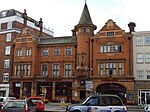All Saints Church, Fulham
Church of England church buildings in the London Borough of Hammersmith and FulhamChurches on the ThamesDiocese of LondonFulhamGrade II* listed buildings in the London Borough of Hammersmith and Fulham ... and 4 more
Grade II* listed churches in LondonHistory of the London Borough of Hammersmith and FulhamMajor Churches NetworkUse British English from February 2015

All Saints' Church is the ancient parish church of Fulham, in the County of Middlesex, pre-dating the Reformation. It is now an Anglican church in Fulham, London, sited close to the River Thames, beside the northern approach to Putney Bridge. The church tower and interior nave and chancel are Grade II* listed.
Excerpt from the Wikipedia article All Saints Church, Fulham (License: CC BY-SA 3.0, Authors, Images).All Saints Church, Fulham
Putney Bridge Approach, London Parson's Green (London Borough of Hammersmith and Fulham)
Geographical coordinates (GPS) Address External links Nearby Places Show on map
Geographical coordinates (GPS)
| Latitude | Longitude |
|---|---|
| N 51.4686 ° | E -0.2117 ° |
Address
All Saints Church
Putney Bridge Approach
SW6 3JD London, Parson's Green (London Borough of Hammersmith and Fulham)
England, United Kingdom
Open on Google Maps










